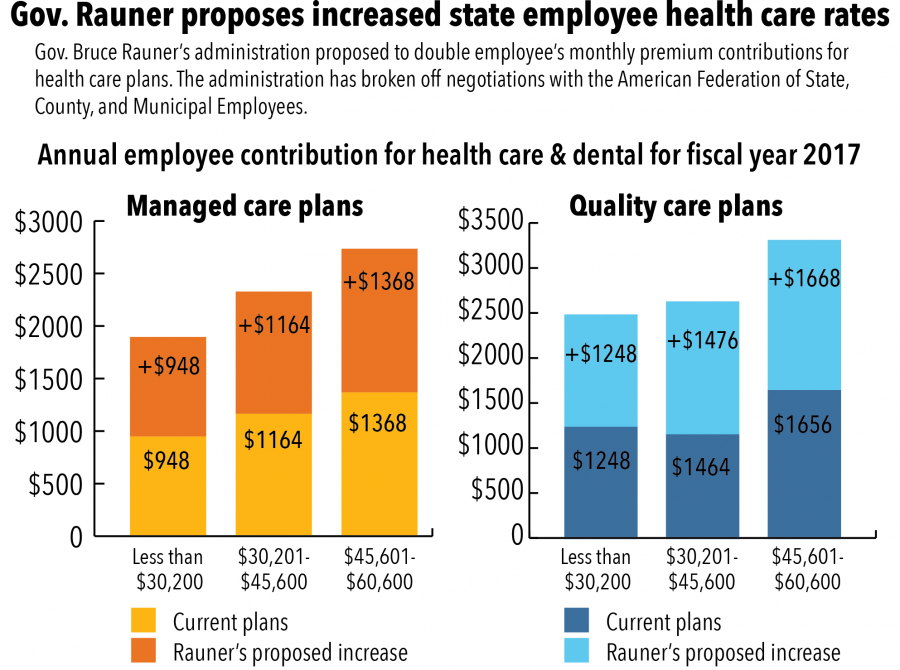UI employees could face increased healthcare costs or less coverage
Sep 21, 2016
Some say Illinois has not been a good health care partner.
Claudia Lennhoff, executive director of the Champaign County Health Care Consumers, is one of those people. She warned faculty members about ongoing health care issues with the state at a panel on Wednesday held by the Campus Faculty Association.
Since February 2015, there have been threats of Illinois increasing state employees’ health care costs or not providing as much medical coverage. And since the budget impasse, the state has not been reimbursing health care providers.
Before national attention to health care was increased because of the Affordable Care Act, people who lacked health insurance lived with treatable health issues and died younger from preventable conditions, she said.
But while the rest of the nation continues to move forward with providing health care to more people, she worries that the proposed price increases will move Illinois backward.
Get The Daily Illini in your inbox!
Patients with state insurance are being turned away by providers who are unable wait 300 to 550 days to be reimbursed by the state.
Through the stopgap budget approved by the General Assembly and Gov. Bruce Rauner, the state was able to start catching up on payments after they halted last year during the ongoing budget impasse.
Around five faculty members voiced concern that the University administration has been reluctant to complain too much about the threat of increased health care costs because they are currently focused on simply receiving a budget from the state.
The University held a forum in June to explain the situation to employees and provide as much information as is available.
Dorothee Schneider, history lecturer, said the University has to remain competitive with its health insurance plans so it can retain and recruit faculty.
In Illinois, the state’s largest government-worker union negotiates health insurance plans for all state employees. 38,000 state employees are represented through the American Federation of State, County and Municipal Employees Council 31 union, which has been in negotiations with Rauner’s administration since February 2015.
Lennhoff said in the last five years, the organization is seeing employer-based health plans shift costs onto the employee through deductibles, which are a set amount employees pay for medical services before insurance covers the rest.
“$800 in the world of health insurance is not terrible, but when somebody is making $25,000 a year, that is a big hit,” she said. “With higher deductible plans, lower income people withhold getting health care, they withhold going to the doctor, getting prescriptions and getting health care.”
David Beck, staff representative for the Employee Council 31 union, said there is not a lot of information he can provide about what the governor is proposing for health insurance plans because they have not negotiated any details.
“He immediately was 100 percent on the offensive about everything, not just health insurance,” Beck said. “It was very clear to us from the beginning that his whole goal was to break the union and essentially try to force us on strike.”
In Rauner’s last offer, he proposed two possibilities: keep the same health insurance plans at double the cost or keep the same cost but with higher copays and not as much coverage.
Nadja Robot, vice president of the Employee Council 31 union, said many members of the union are some of the lowest paid people on campus, with some barely making $30,000.
“Some of these workers are single parents supporting children or they are the only person in the household working, so seeing any increase in health care is incredibly devastating because (they) are the most vulnerable on campus.”
Rauner’s administration made it clear that his goal is to shift the cost of health care and take a certain amount of money from employees so that the state does not have to pay as much, Beck said.
Currently, employees are paying around 17 percent of the total cost, and Beck said that Rauner hopes to shift the cost to 33 percent.
This would make Illinois have the worst state health insurance for any state in the country, he said, adding that the state is currently average in comparison to other states as far as cost goes.
Negotiations stalled in January when Rauner’s administration said the negotiations were at a stalemate. It was left to an administrative law judge to determine where negotiations stand.
The judge gave a mixed decision Sept. 2, ruling Rauner’s team had reached a stalemate on some issues, but they need to return to the bargaining table on other issues — including health care.
This ruling isn’t the final decision though, as members of the Illinois Labor Relations Board also have a say. Beck, however, said that the majority of members of the board were appointed by Rauner.
Beck said they expect Rauner to impose his final best offer, and then the union will have to decide whether to strike or appeal the decision. Overall, he does not think anything will be finalized until the end of November.
“Having public unions in the public sector brings a strong collective voice for public employees and it serves a larger public good,” Gilbert said. “We now find ourselves with a governor who is determined to break unions in both private and public sector.”
@MeganAsh_Jones






